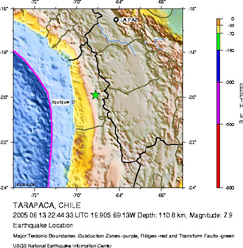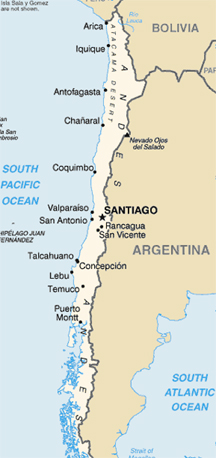Geotimes

Untitled Document

Web Extra
Tueday, June 14, 2005
 Quake
shakes Chile
Quake
shakes Chile
 At
6:44 p.m. local time on Monday, a magnitude-7.8 temblor rocked northern Chile
and was felt throughout parts of Peru and Bolivia, including in the capital
city of La Paz, according to the U.S. Geological Survey (USGS). The quake was
centered in the remote and mostly unpopulated northern Andes region of Tarapaca,
about 115 kilometers northeast of the port city of Iquique (with about 250,000
residents) and 1,515 kilometers north of the capital, Santiago.
At
6:44 p.m. local time on Monday, a magnitude-7.8 temblor rocked northern Chile
and was felt throughout parts of Peru and Bolivia, including in the capital
city of La Paz, according to the U.S. Geological Survey (USGS). The quake was
centered in the remote and mostly unpopulated northern Andes region of Tarapaca,
about 115 kilometers northeast of the port city of Iquique (with about 250,000
residents) and 1,515 kilometers north of the capital, Santiago.
At right, the green star marks the epicenter
of a magnitude-7.8 earthquake that struck northern Chile at dinnertime on Monday.
Reports suggest shaking was felt as far away as Santiago, Chile, 1,515 kilometers
south of the epicenter. Images courtesy of USGS.
The earthquake has resulted in at least eight deaths and an untold number of
injuries, according to an Associated Press report. Because of the remoteness
of the mountainous area, injury and damage reports are slow to come in. Although
residents in La Paz took to the streets in panic when the earthquake struck,
no damage has been reported there. In Iquique, power supply and communications
were interrupted.
On the USGS "Did you feel it?" Web site, people
have reported shaking as far away as Santiago and Sao Roque, Brazil, which is
about 2,310 kilometers away.
According to USGS, the earthquake resulted from the release of stress from
the subduction of the Nazca plate beneath the South American plate. Subduction
zones, such as the one involved in the large Dec. 26 Sumatra quake, produce
the planet's largest earthquakes. The largest temblor of the past century is
the 1960 magnitude-9.4 quake that ruptured 900 kilometers along the Peru-Chile
subduction zone, about 2,000 kilometers south of Monday's quake. That event
killed more than 2,000 people.
Compiled by Megan Sever
Links:
USGS
National Earthquake Information Center
USGS
"Did you feel it?"
Associated
Press story on CNN.com
Back to top
Untitled Document

 At
6:44 p.m. local time on Monday, a magnitude-7.8 temblor rocked northern Chile
and was felt throughout parts of Peru and Bolivia, including in the capital
city of La Paz, according to the U.S. Geological Survey (USGS). The quake was
centered in the remote and mostly unpopulated northern Andes region of Tarapaca,
about 115 kilometers northeast of the port city of Iquique (with about 250,000
residents) and 1,515 kilometers north of the capital, Santiago.
At
6:44 p.m. local time on Monday, a magnitude-7.8 temblor rocked northern Chile
and was felt throughout parts of Peru and Bolivia, including in the capital
city of La Paz, according to the U.S. Geological Survey (USGS). The quake was
centered in the remote and mostly unpopulated northern Andes region of Tarapaca,
about 115 kilometers northeast of the port city of Iquique (with about 250,000
residents) and 1,515 kilometers north of the capital, Santiago.
 Quake
shakes Chile
Quake
shakes Chile
